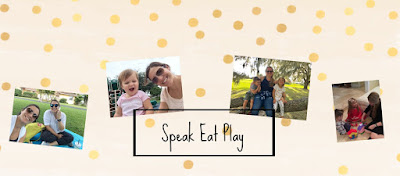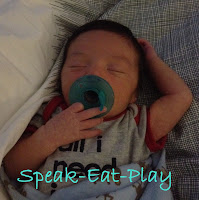What you may not know about a pacifier
by Karina Gonzalez, MS CCC-SLP
What is my biggest pet peeve? Seeing a toddler with a pacifier! There have even been times that I have seen 4 year olds with a paci in their mouths. Parents if this is your child, please don’t be offended, instead keep reading, I’m here to help. I’m sure every speech-language pathologist feels the same about the dreaded binky, tete, boopy, chupi, mimi, paci, sucky, etc. This innocent looking device is a speech development’s worst nightmare. Well I might be exaggerating a little, but I’m trying to prove a point. Don’t get me wrong, a pacifier serves a purpose in an infant’s life. It helps with soothing, calming and comforting babies, as well as quenching the instinctive desire to suck. This is a behavior that develops in utero, prenatal imaging has shown babies sucking their thumb or fingers before birth, so it’s only natural for your baby to want to suck. Another advantage of a pacifier is that it helps promote the sucking reflex in premature infants. Pacifiers have also been linked reducing the risk of sudden infant death syndrome (SIDS).
However, these benefits apply only to early infancy, as your baby grows the benefits decrease and they begin to wreak havoc in your baby’s mouth including…
However, these benefits apply only to early infancy, as your baby grows the benefits decrease and they begin to wreak havoc in your baby’s mouth including…
· Prolonged use of pacifier leads to poor development and misalignment of teeth, such as:
Anterior open bite: The top incisors do not meet the bottom ones, leaving a gap between the two when the mouth is closed. This causes the tongue to slip out during speech production, resulting in a lisp. It is also difficult for these kids to take a bite of food.
Cross bite: The arch of the top teeth is narrower than the bottom and therefore the top and bottom molars do not meet. This can affect one or both sides of the mouth. This can distort the production of speech sounds.
Over jet bite: Upper teeth are more anterior than lower teeth.This also results in the development of a lisp.
· Prolonged pacifier sucking also leads to a tongue thrust, in which the tongue extends past the lips during speech production (lisp) and swallowing. This is what Sylvester the Cat from Looney tunes sound like.
· There’s also a correlation between pacifier use and occurrence of ear infections (otitis media).
· Pacifier sucking increases drooling.
· Babbling and imitation of sounds and words may be limited with the pacifier occupying the oral cavity, or the child may choose to not speak at all.
· Oral exploration is also limited by continuous use of pacifier through out the day. Your baby needs to mouth objects for proper develoment, such as a blanket, hands, toys, etc.
So when is the optimal age to eliminate the pacifier? Well this is the topic of great debate between speech therapists, dentist, parents and grandparents. But if you ask me, you should discontinue as soon as possible, especially before it interferes with your child’s speech development, which begins early on (see my post for reference: Speech and Language Milestones) or at least by the first birthday.
But, easier said than done, right? Well here are some tips on making it easier to get rid of the binky…
· Cold turkey! Yes, your child will scream and cry, but eventually they will forget about it.
· Start early, parents have told me that the earlier they take it away, the easier. Young babies tend to forget a lot quicker than toddlers and tend to find other ways to soothe themselves.
· Give it away, if your child is old enough to understand the concept, you can have him give it to Santa at the mall, to the Binky Fairy, or even to a newborn as a gift. This gives your child a great sense of independence and pride.
· You can take it away slowly by restricting it to certain times of the day, only nap time, or leaving it at home when you go out.
· You can lose it! The next time you child asks for it, pretend to look for it and then say you lost it.
· You can anticipate when your child will ask for it and instead distract him with an activity, such as looking through a colorful book, playing a game, etc.
I hope you can use any of these ideas, just keep in mind that even though it will be hard and your child will be upset, you are serving a great benefit. You will be promoting a great smile and intelligible speech, not to mention the money you will save on orthodontist visits and speech therapy.
But the problem does not end with the pacifier, see my post on when to get rid of the bottle, HERE. HERE'S a great sippy cup for transitioning off the bottle.
If you have any other ideas or ways to get rid of the pacifier, please comment below, I would love to hear and share other tricks that have worked for you.
If you have any other ideas or ways to get rid of the pacifier, please comment below, I would love to hear and share other tricks that have worked for you.
Be sure to follow our blog for notification on useful future posts and please share with friends and family.







No comments:
Post a Comment